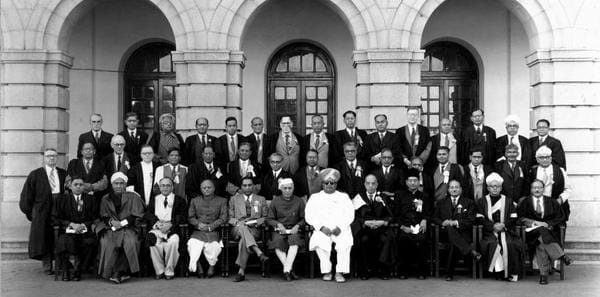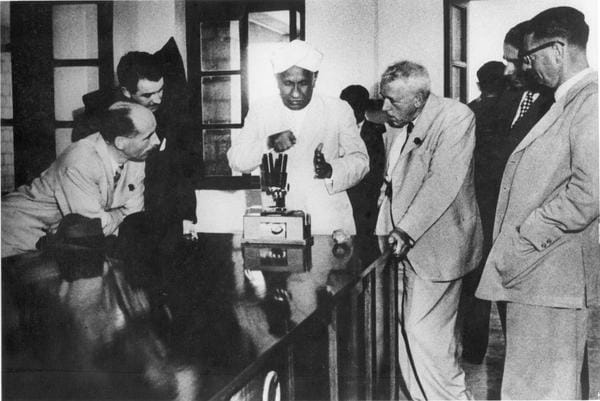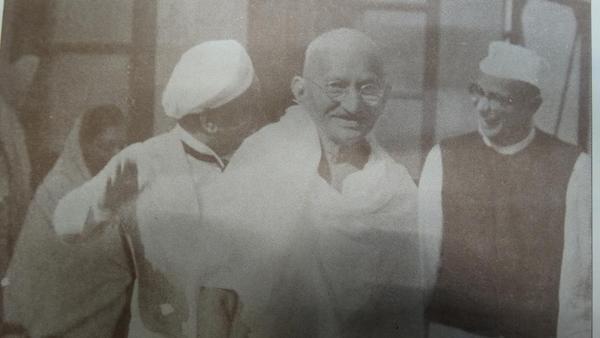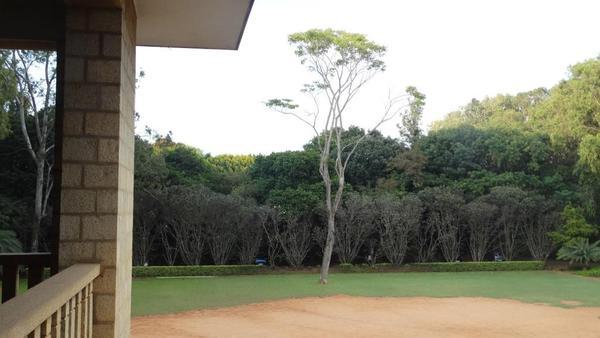Part I: How C V Raman came to Bangalore
Part II: The Raman Effect on Indian Institute of Science
Part III: Raman, his research institute and his many hobbies
The collection of specimens in his museum and his reputation as the greatest scientist of India attracted many visitors from around the world to Raman’s institute. But not all were welcome. Proposals made by government representatives to offer Raman the much-needed funds, only if he could in exchange provide the government with certain kinds of research helpful for Defence Ministry, had enraged him. He had developed a natural distrust and aversion towards politicians.
The warmest welcome received at this institute was by Jayachamarajendra Wodeyar, to whom Raman rolled out a red carpet. The former Maharaja of Mysore, whose patronage for science and art had won Raman’s reverence, had then accepted the Governorship of Madras after independence when princely states were no more and Mysore kingdom had become Karnataka state.
When Nehru thought what glittered was gold
When Nehru paid a visit to the institute, Raman welcomed him by offering a fresh rose, which he fixed in his buttonhole, and walked him to the museum. Here Raman turned off the overhead light, leaving only the UV lights on, and placed a piece of copper and a piece of gold on Nehru’s palm, asking him to identify which was gold. Nehru, promptly picked the one that appeared brighter under the glow of ultra-violet light, and Raman burst out in a mocking laughter, saying, “Mister Prime Minister, all that glitters is not gold.”
From the museum they walked to the library where Raman introduced his students to Nehru, before taking him to the lecture theatre and delivering a 15 minute lecture about how an endowed chair was indispensable for the future of the institute, suggesting that the government could assist in creating it by offering a one million rupees fund, without any strings attached.
Raman and Nehru meeting each other. Pic courtesy: Raman Research Institute
Nehru said, “Raman, why do you worry about the future of your institute? The government will gladly take care of it”, to which Raman replied, “Sir, who can predict the fate of politicians and what they say? I want an unconditional commitment from you now. I certainly don’t want this to become another government laboratory.” Nehru managed to move on with a smile without making any further comments on it.
Although they parted company cordially, Raman was disappointed that his appeal to Nehru did not secure any funds for the institute immediately, even though he knew that the Prime Minister, being answerable to the Parliament, could not make such commitments.
With age, he grew more and more disenchanted with Nehru, for he believed the flawed policies of his government were hindering scientific progress.
Uma Parameshwaran, in her book on C V Raman, summarized his opinion of Nehru in the statement, “Nehru had chosen the copper piece (thinking it was gold) again and again, fooled by light that did not emerge from the natural light of wisdom.”

Sir C V Raman, with first Prime Minister of Indipendent India Pandit Jawaharlal Nehru and Jayachamaraja Wodeyar, Maharaja of Mysore State. Pic courtesy: Raman Research Institute
Angry over government control
Raman was outraged at the government’s use of its power to grant funds as a means to establish control over research institutes and flatly rejected any funds that the government was willing to offer, so long as conditions, even simple ones like having to provide it with an annual report of expenditure, were applied. The general direction of scientific progress and the politics of scientific administration, combined with the disappointment wrought upon him when all of his closest students left the institute and went abroad or to different cities to pursue their own paths, made him very cynical in the last decade of his life.
In one of his lectures about a series of experiments that required platinum, he remarked that he had found his first sliver of platinum, when he, in a fit of rage against the government’s ill-conceived policies on science, had smashed his Bharat Ratna medal, the highest civilian honour, conferred on him in the year 1954.
Raman’s twilight years
In his twilight years he is known to have said: “My life has been an utter failure. I was the first Asian to bring home the Nobel Prize in the scientific field. I thought I would bring true science in our country. But all we have now is a legion of camp followers of the West. There can be no salvation; no real advance at this rate.” Nonetheless, undeterred by his own cynicism, he continued his pursuit of science and research in isolation till the very end of his life.
By the year 1968, Raman had grown weak and his health had started to fail. He had bequeathed all his personal wealth and property to the institute. “I have always felt that science can only flower when there is an internal urge. It cannot thrive under external pressures. I strongly believe fundamental science cannot be driven by instructional, industrial, governmental or military pressures. This was the reason why I decided not to accept money from Government.”
He said to an associate, expressing his wishes for the future of the institute after his demise. “I am practical enough to see that it would not be possible for others to run or grow a good institution without funds. I have bequeathed all my property to the Institute. Unfortunately this may not be sufficient… I, therefore, will not put it as a condition that no government funds should be accepted by the institute; I would, however, strongly urge taking only funds that have no string attached.”

Raman at the laboratory. Pic courtesy: Raman Research Institute
Preparing for the last journey
After his last lecture, “Cochlea and the Perception of Sound,” delivered at Gandhi memorial hall , which he had established at Raman Research Institute as a tribute to Mahatma, on 2nd of October 1970, for the first and the only time ever, he requested the audience for permission to sit down while answering their questions.
In the last week of October, he was rushed to hospital when he collapsed in his laboratory. The valves of his heart had given away and the doctors gave him four hours to live. But he survived and after a few days refused to stay at hospital, saying that he would rather want to die in the gardens of his institute, surrounded by flowers.
As per his wishes he was moved to his villa in the institute. Laying on his bed, he wished he had constructed the windows of his room at a lower height so that he could gaze the flower garden outside, without having to sit up. So his bed was raised to allow him the sight. Two days before his death, Raman convened a meeting from his bed to finalise and sign the legal documents of the institute. After all the necessary signatures were secured, Raman carefully glanced through the document again and spotted a typographical error and had it corrected. He then instructed his wife to arrange a simple cremation at the institution gardens, without any “ritualistic mumbo jumbo”.
Remembering Mahatma on the deathbed
Raman, Gandhi and Mahadeo Desai. Pic courtesy: Raman Research Institute
The next day, Raman still had much to say, but was incoherent and his speech was unintelligible. When Lokam, the name by which he addressed his wife in private, sitting by his deathbed, told him to remember God and take his name, he said, “I believe only in the spirit of man… I have heard of godly men, Jesus, Buddha, and I have met a godly human being – Mahatma Gandhi.”
The next morning, on 21st November 1970, he breathed his last at 7.20 am. The news of his demise first broke on All India Radio in the Kannada morning news and a holiday was declared. Thousands poured into the institute, many with welled up eyes, to pay homage to the body.
Early that afternoon, after securing permission, Raman was cremated on the grounds of the institute. Prima Vera, planted at the spot where his body was cremated, has today grown to be the tallest, towering over all other trees in the institute. When this tree did not have a single flower bloom over the next ten years, many at the institute were disappointed thinking they had perhaps planted the wrong tree.
Prima Vera, the Raman Tree grown in the location where Raman was cremated. Pic: Shree D N
But then in 1988, the year which marked 100 years after Raman’s birth, the tree bloomed with bright yellow flowers densely covering all its branches. Today from his pillared porch over the portico, the view, not of Nandi Hills, but of the concrete jungle right outside the institute, is blocked by trees that have now grown taller than the buildings it surrounds on all sides.
And the Raman Research Institute has expanded its areas of research, its library and the facilities in its laboratories beyond what Raman could ever have imagined.
References:
- C. V. Raman : A Biography by Uma Parameswaran
- C. V. Raman – A Memoir by A. Jayaram
- Journey into Light by G. Venkataraman
- C.V. Raman – A Pictorial Biography By Prof. Ramasheshan
- Conversations of the reporter with Mrs. Ramasheshan
Related Articles
The Raman Effect on Indian Institute of Science
How C V Raman came to Bangalore
Raman, his research institute and his many hobbies



‘@ The warmest welcome received at this institute was by Jayachamarajendra Wodeyar, to whom Raman rolled out a red carpet. The former Maharaja of Mysore, whose patronage for science and art had won Raman’s reverence, had then accepted the Governorship of Madras after independence when princely states were no more and Mysore kingdom had become Karnataka state. ……
This needs some elaboration and clarification !
The land for Raman Institute near Mehkri Circle, Bangalore the Maharaja to Sir C. V. Raman !
Maharaja did not accept Governorship of Madras State immediately after India became an Independent Dominion on 15-8-1947. Mysore and most of the Princely States remained independent Kingdoms till 26-1-1950 though they had signed Instrument of Accession. After India became a Sovereign Republic in 1950, Mysore became a Part-B State and Maharaja was axiomatically its Raja Pramukh. After the Re-organization of States on linguistic basis in 1956, Raja Pramukh post was abolished and yet Maharaja was appointed as the Governor of the New Mysore State ( rechristened as Karnataka in 1973). Maharaja continued as the Governor till 1964. He was appointed as the Governor of Madras ( now Tamil Nadu) in 1964. He resigned in 1966.
Sir C.V. Raman’s admiration for the Maharaja can be gleaned from the speech he gave at the special convocation of University of Mysore on 12-7-1962 to confer Doctor of Laws, honoris causa to the Maharaja.
” I would begin by saying that we recognize in His Highness a true son of Mother India whose voice is the authentic voice of our ancient land……
… No one could claim to have really understood India who is not familiar with Sanskrit and is not steeped in the knowledge that has come to us thro’ ages in that language. His Highness’s mastery over Sanskrit will be evident to anyone who has perused his translation of the works and his exposition of the philosophy of Dattatreya………
…. There is in the Sanskrit language a word Rajarishi, meaning one who is a Ruler and a Sage which aptly describes the personality and attainment of His Highness. ….